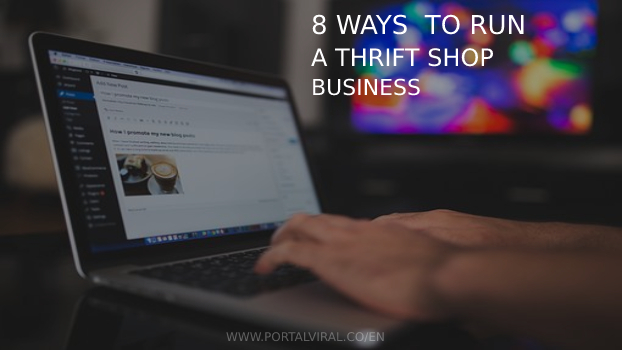Are you interested in the idea of running a 8 Ways to Run a Thrift Shop Business? How to start a Thrift Shop business from the beginning? Here are the steps. You must be familiar with the Thrift Shop business or second-hand store.
A Thrift Shop is a great business idea for beginners. And its presence has increased lately regarding clothing in Thrift Shops.
Why starting a business can be profitable and good for beginners? One reason is because you do not need to produce goods yourself.
If you are also interested in starting your own second-hand clothing business, read this article to know 8 ways to run a thrift shop business.
What is Thrift Shop?
Selling used items such as clothing, books, and household equipment is called a Thrift Shop. Although used, the items sold are still in good quality and some of them are like new.
There are many products that can be sold in second-hand/Thrift Shops. But the most popular item is clothing, where the trend changes quickly. If you sell your own used items, it’s called preloved, not a Thrift Shop.
Preloved itself is an item that was previously used and given to someone else. Preloved is also called used items or Thrift. In other words, Preloved is a Thrift item that has been resold in very good condition.
Tips For Starting a Thrift Shop Business!
Here are 8 ways to run a Thrift Shop business that you can try if you are interested in this business.
1. Determine The Target Market and Products
There are many used items that you can sell. These include bags, watches, electronics, books, clothing, household items. Different products may have different target markets.
Household items, for example, are targeted at homemakers and retirees. However, clothing and electronics have different target markets.
So, determine what products you will be selling. This type of Thrift Shop business makes it easy to determine the target market, build the business function, create content, and more.
For example, people who like items with a simple and cute concept and pastel colors that are currently trending.
From here, you can determine the concept for product photography, Instagram feed, brand name, packaging, and marketing content.
2. Find and choose the right supplier
Then you need to find the right supplier for your storage needs. You can even sell them in used goods stores such as Pasar Simor Gede Bage in Bandung or Pasar Sennen in Jakarta.
Of course, choosing one by one will take a long time. Obtaining supplies from domestic and foreign suppliers is the main key. Used clothing is usually sent in large bags.
When choosing a supplier, one supplier must be compared with another. As a general rule, different providers have different prices, product quantities, and equipment.
3. Create a Brand Name & Logo
When you run a Thrift Shop business, but you can add a label, sticker, or thank-you card with your brand name and logo.
Not only can it display your brand, but it can also make buyers feel like they are buying new clothes.
Currently, most of the clothes in used goods stores are washed, ironed, or steamed, then packaged one by one.
4. Maintain Product Cleanliness
Having good quality, but often sent in large quantities from abroad can also be with used goods aka thrif. Therefore, it is important to maintain the cleanliness of the product.
For example, if clothes are sent in a large bag, the clothes will be wrinkled and you won’t know if the clothes are clean or not. Therefore, the product must be washed and ironed first before being sold.
Maintaining your goods clean means staying healthy as a seller, keeping your storage space clean, and clean clothes make it easy for you to photograph your goods.
5. Take Product Photos
You need product photos that can be uploaded to social media, e-commerce, or marketplaces so that your products can be sold online for your Thrift Shop business.
Product photos don’t have to be taken at a special photo studio. You can do it on your phone at home. What’s important is the placement of the object, lighting, and how the photo is taken.
Clothes can be hung on a hanger, arranged neatly on a table, or folded and arranged on a shelf. Electronics can be placed on a table or a neutral background.
6. Use Social Media and E-commerce Platforms
Social media and e-commerce platforms are a good way to promote your Thrift Shop business. You can use Instagram, Facebook, TikTok, and other platforms to promote your products.
You can also use e-commerce platforms like Shopee, Tokopedia, Bukalapak, and others.
7. Promote Your Product
After you have an idea of your product and price, it’s time to market your thrift shop business. You can sell it through various online media.
For example, post to Instagram, sell on TikTok, post on Facebook, or use e-commerce platforms.
When using multiple media at the same time, be prepared to create various marketing content. Some social media platforms are mostly photos, while others are mostly videos.
For example, TikTok focuses on videos, while Instagram can include both.
Don’t forget to provide the necessary information. For example, on Instagram and Facebook, include the brand, size, material, price, and any defects of the product.
Some thrift store products may have defects such as small holes, loose buttons, or dirtiness.
8. Create The Right Marketing Strategy
With the right marketing strategy, a thrift shop business can also generate a lot of money. This marketing strategy can be tailored to the target market and the sales media you choose.
For example, if the target market is young adults over the age of 20 and social media platforms such as Instagram and TikTok are the most accessed by them, then these can be suitable advertising media.
In addition, the marketing content used must also be appropriate for the media and the way the thrift shop business is run.
For example, you can promote directly through TikTok or if you are in e-commerce, Shopee usually advertise products with certain sellers.




